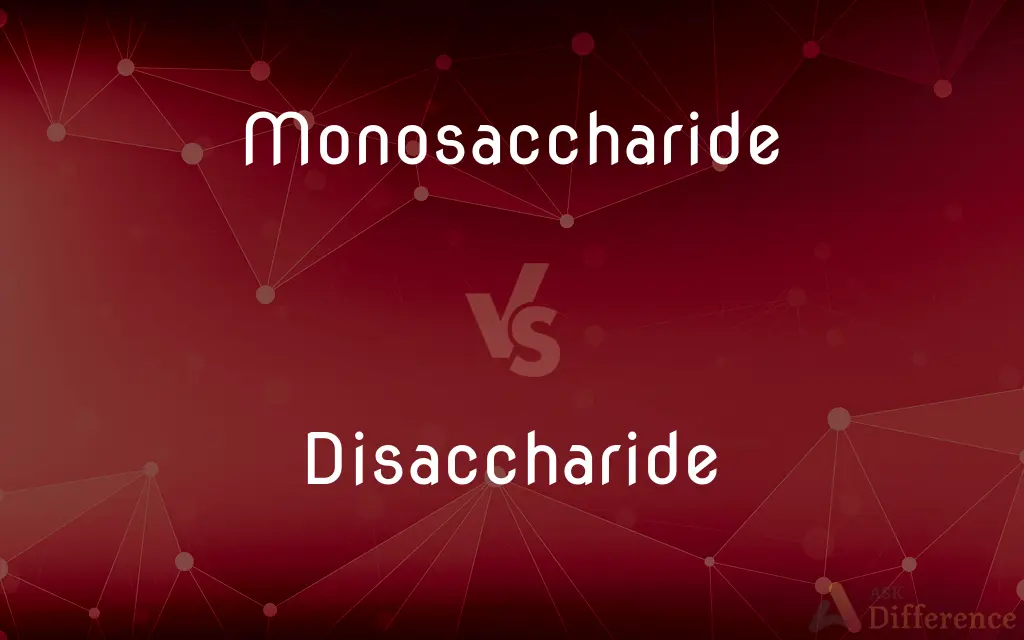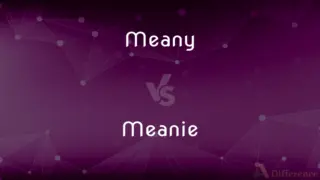Monosaccharide vs. Disaccharide — What's the Difference?
Edited by Tayyaba Rehman — By Fiza Rafique — Updated on November 3, 2023
A monosaccharide is the simplest form of carbohydrates consisting of a single sugar molecule, while a disaccharide is composed of two bonded monosaccharides.

Difference Between Monosaccharide and Disaccharide
Table of Contents
ADVERTISEMENT
Key Differences
Monosaccharides are the simplest form of sugar and the most basic units of carbohydrates. They are single sugar molecules that cannot be hydrolyzed into simpler sugars. Common examples include glucose, fructose, and galactose, each playing a crucial role in energy production for living organisms. Their structure allows them to be quickly absorbed by the body, providing an immediate source of energy.
Disaccharides consist of two monosaccharide molecules joined together by a glycosidic bond. The formation of this bond is a dehydration reaction, where a molecule of water is removed. Sucrose, lactose, and maltose are typical disaccharides that are found in various food products. These sugars are used by the body for energy but must be broken down into monosaccharides before they can be absorbed.
While monosaccharides are single-molecule sugars, disaccharides are more complex and must be digested into their simpler forms to be utilized. The digestion of disaccharides into monosaccharides is an essential digestive step that occurs in the small intestine, involving enzymes such as sucrase, lactase, and maltase that target specific disaccharides.
The physical properties of monosaccharides and disaccharides differ due to their structural differences. Monosaccharides typically have a sweet taste and are soluble in water, making them easy to transport through the bloodstream. Disaccharides, being larger molecules, may not be as sweet and require an additional digestion step to convert them into absorbable sugars, which can affect how they influence blood sugar levels.
Comparison Chart
Number of Sugar Units
One
Two
ADVERTISEMENT
Types
Glucose, Fructose, Galactose
Sucrose, Lactose, Maltose
Digestion
Absorbed directly
Must be broken down
Role in Diet
Quick energy
Energy, taste, texture
Chemical Structure
Simple
More complex due to bond
Compare with Definitions
Monosaccharide
A single unit of sugar with the general formula C6H12O6.
Galactose, a monosaccharide, combines with glucose to form lactose.
Disaccharide
A sugar composed of two monosaccharides joined by a glycosidic bond.
Sucrose is a disaccharide made of glucose and fructose.
Monosaccharide
The simplest form of carbohydrate and the basic unit of sugars.
Fructose is a monosaccharide found in many fruits.
Disaccharide
A complex sugar that must be broken down into monosaccharides to be utilized by the body.
Table sugar, a common disaccharide, is used in baking.
Monosaccharide
A single sugar molecule that cannot be hydrolyzed to simpler sugars.
Glucose, a monosaccharide, is vital for cellular energy.
Disaccharide
Sugars that provide energy and are involved in various biological processes.
Disaccharides are often found in foods as added sweeteners.
Monosaccharide
Simple sugars that serve as fuel molecules in biological organisms.
Monosaccharides are the quickest source of energy in the human diet.
Disaccharide
A carbohydrate formed when two sugars are joined and a molecule of water is removed.
Lactose, a disaccharide in milk, is digested by the enzyme lactase.
Monosaccharide
Fundamental units of carbohydrates and essential sources of energy.
Dietary monosaccharides are found in honey and fruits.
Disaccharide
Double sugar molecules that are part of the carbohydrate family.
Maltose, a disaccharide, is produced during the breakdown of starch.
Monosaccharide
Monosaccharides (from Greek monos: single, sacchar: sugar), also called simple sugars, are the simplest form of sugar and the most basic units (monomers) of carbohydrates. The general formula is CnH2nOn, or [Cn(H2O)n] or { CH2O}n albeit not all molecules fitting this formula (e.g.
Disaccharide
A disaccharide (also called a double sugar or biose) is the sugar formed when two monosaccharides are joined by glycosidic linkage. Like monosaccharides, disaccharides are simple sugars soluble in water.
Monosaccharide
Any of several carbohydrates, such as tetroses, pentoses, and hexoses, that cannot be broken down to simpler sugars by hydrolysis. Also called simple sugar.
Disaccharide
Any of a class of sugars, including lactose and sucrose, that are composed of two monosaccharides.
Monosaccharide
(carbohydrate) A simple sugar such as glucose, fructose or deoxyribose that has a single ring
Disaccharide
(carbohydrate) Any sugar, such as sucrose, maltose and lactose, consisting of two monosaccharides combined together.
Monosaccharide
A simple sugar; any of a number of sugars (including the trioses, tetroses, pentoses, hexoses, etc.), not decomposable into simpler sugars by hydrolysis. Specif., as used by some, a hexose. The monosaccharides are all open-chain compounds containing hydroxyl groups and either an aldehyde group or a ketone group.
Disaccharide
Any of a variety of carbohydrates that yield two monosaccharide molecules on complete hydrolysis
Monosaccharide
A sugar (like sucrose or fructose) that does not hydrolyse to give other sugars; the simplest group of carbohydrates
Common Curiosities
Can monosaccharides be directly used by the body?
Yes, monosaccharides can be directly absorbed into the bloodstream without digestion.
Do disaccharides occur naturally?
Yes, disaccharides like sucrose and lactose occur naturally in plants and animal products.
What enzymes break down disaccharides?
Enzymes like sucrase, lactase, and maltase break down disaccharides.
What is a monosaccharide?
A monosaccharide is a simple sugar molecule and the most basic unit of carbohydrates.
What is a disaccharide?
A disaccharide is a sugar formed by the combination of two monosaccharides.
What is the role of monosaccharides in plants?
Monosaccharides serve as building blocks for energy storage and structural components in plants.
Is fructose a monosaccharide or a disaccharide?
Fructose is a monosaccharide.
Are monosaccharides sweet?
Yes, monosaccharides like glucose and fructose are typically sweet-tasting.
Why must disaccharides be digested?
Disaccharides must be broken down into monosaccharides for absorption and use by the body.
What is the most common monosaccharide in the human diet?
Glucose is the most common and important monosaccharide in the human diet.
How do disaccharides affect blood sugar levels?
Disaccharides increase blood sugar levels once digested into monosaccharides.
Are all disaccharides equally sweet?
No, the sweetness of disaccharides can vary depending on their constituent monosaccharides.
Are monosaccharides only found in sweet foods?
No, monosaccharides are present in various foods, not just sweet ones.
Can people have difficulty digesting disaccharides?
Yes, conditions like lactose intolerance arise from the inability to digest certain disaccharides.
What is a common source of disaccharides in the diet?
Common sources include table sugar (sucrose), milk (lactose), and malted foods (maltose).
Share Your Discovery

Previous Comparison
Meany vs. Meanie
Next Comparison
Dean vs. ProvostAuthor Spotlight
Written by
Fiza RafiqueFiza Rafique is a skilled content writer at AskDifference.com, where she meticulously refines and enhances written pieces. Drawing from her vast editorial expertise, Fiza ensures clarity, accuracy, and precision in every article. Passionate about language, she continually seeks to elevate the quality of content for readers worldwide.
Edited by
Tayyaba RehmanTayyaba Rehman is a distinguished writer, currently serving as a primary contributor to askdifference.com. As a researcher in semantics and etymology, Tayyaba's passion for the complexity of languages and their distinctions has found a perfect home on the platform. Tayyaba delves into the intricacies of language, distinguishing between commonly confused words and phrases, thereby providing clarity for readers worldwide.















































